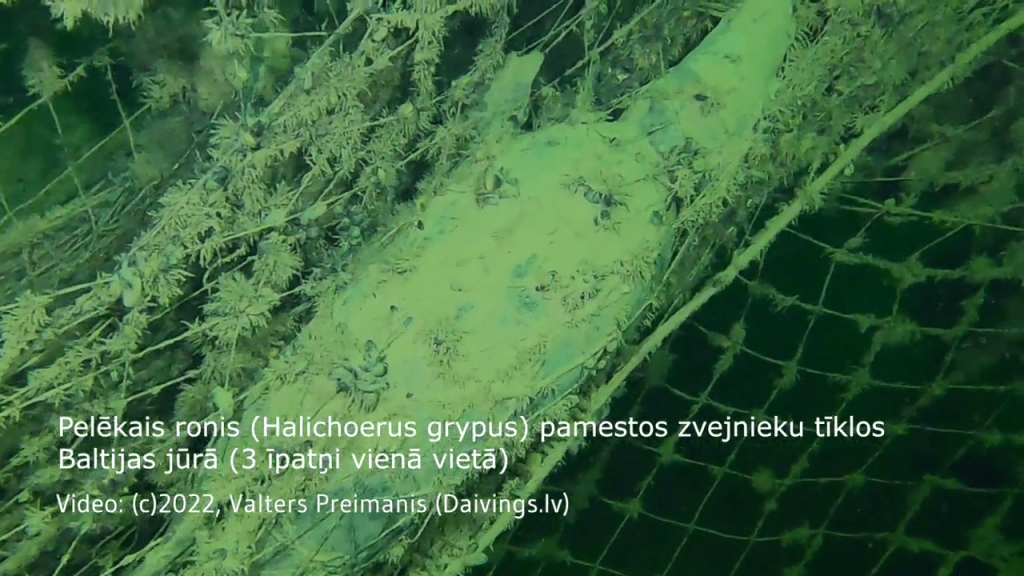A team of volunteer divers from the diving club "Daivings", members of "Vesala jūra", has done an impressive job cleaning the Baltic Sea from a dangerous "ghost net".
Near the coast of the Gulf of Riga, in front of the Kalngale beach, they unearthed a three-ton old fishing net, which posed a threat to both the safety of navigation and the inhabitants of the sea.
Divers bring out a ghost net from the Baltic Sea
"Ghost nets" are abandoned or lost fishing gears that continue to "fish" long after they have disappeared to the seabed. They become deadly traps for marine life and also pollute the environment with microplastics. This problem is especially acute in the Baltic Sea, which is estimated to contain thousands of such "ghosts".
Lifting buoys with a total buoyancy of 3 tons were used to lift the net
This time, thanks to the determination and skills of the Daivings team, one of these dangerous nets has been lifted out of the water. The operation was complex and time-consuming, with five lifting buoys used to raise the net, and it was lifted out with metal anchors.
"This abandoned net not only threatened the safety of navigation, but also continued to catch fish, which died after getting entangled in it," says Valters Preimanis, representative of the diving club "Daivings". "We are pleased that we were able to contribute to keeping the Baltic Sea clean."
The whole event was carried out voluntarily and in free time, which proves the divers' passion and sense of responsibility towards the environment. In cooperation with "Carnikavas Komunalservis", the net was brought ashore to be dried and disposed of.
This successful operation is a great example of how volunteers can make a significant contribution to environmental protection. The work of the "Daivings" team inspires others to get involved in the fight against "ghost nets" and take care of the cleanliness of the Baltic Sea.
We also invite other divers and nature lovers to join this fight for a cleaner Baltic Sea!

A team of volunteer divers cleans the Baltic Sea of ghost nets: behind the scenes
- In 2008, a huge ghost net weighing approximately 3 tons was discovered in the depths of the Baltic Sea. This finding not only alarmed environmentalists, but also aroused widespread public interest. The fascinating story of how this network was discovered, explored, and ultimately brought to life is a great example of how human enthusiasm and collaboration can create positive change.
Discovery and initial network exploration
Divers, surveying the seabed, discovered the huge, abandoned fishing gear, calling it an "old trawl", a "big murder" or a "standpipe". A thorough documentation of the network was carried out - in 2023, video footage was filmed, measurements were taken and its exact location was recorded. This information provided a detailed picture of the net's size, type and potential damage to the marine ecosystem.
Interest in the huge network was high
News of the massive ghost network quickly spread, attracting the attention of various organizations. There were interested parties who wanted to be the ones to highlight this network and take advantage of this event. Network location information became a valuable “find” and several organizations attempted to extract it.

Daivings team initiative
Regardless of the short deadline, it was the local diving team "Daivings", members of the "Vesala Jūra" society, who took responsibility for raising the net. In 2024, armed with the necessary equipment and immeasurable zeal, the team members, whose number reached 12 people, went on a difficult and risky mission. Using three motorboats, they successfully lifted the huge net, proving that even a small but a motivated team can accomplish great things.
The most important conclusion
This story is a vivid example of how even one fishing gear left behind can pose a serious threat to the marine ecosystem and how important is to agree to join forces to address these issues. Diving the diving team's initiative is an inspiring example of how each of us can do our part to protect the environment.
About us wrote:
- LETA
- TVNET
- Day
- TV3
- LA.LV
- 1188.LV
- NRA.LV
- VIDEO: Divers lift a three-ton net from the bottom, which poses a threat to nature and shipping safetyi https://www.youtube.com/watch?v=T7nAmDBBKLk

